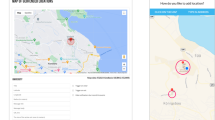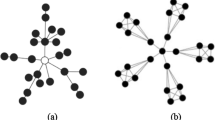Abstract
Since humans are fundamentally social beings and interact frequently with others in their daily life, understanding social context is of primary importance in building context-aware applications. In this paper, using smartphone Bluetooth as a proximity sensor to create social networks, we present a probabilistic approach to mine human interaction types in real life. Our analysis is conducted on Bluetooth data continuously sensed with smartphones for over one year from 40 individuals who are professionally or personally related. The results show that the model can automatically discover a variety of social contexts. We objectively validated our model by studying its predictive and retrieval performance.















Similar content being viewed by others
References
Airoldi EM, Blei DM, Fienberg SE, Xing EP (2008) Mixed membership stochastic blockmodels. J Mach Learn Res 9:1981–2014
Ashbrook D, Starner T (2003) Using gps to learn significant locations and predict movement across multiple users. Pers Ubiquitous Comput 7:275–286
Banerjee N, Agarwal S, Bahl V, Chandra R, Wolman A, Corner MD (2010) Virtual Compass: relative positioning to sense mobile social interactions. In: Proc. Pervasive Computing, pp 1–21
Blei DM, Ng AY, Jordan MI (2003) Latent dirichlet allocation. J Mach Learn Res 3:993–1022
Clauset A, Eagle N (2007) Persistence and periodicity in a dynamic proximity network. In: DIMACS workshop on computational methods for dynamic interaction networks
Dey AK (2001) Understanding and using context. Pers Ubiquitous Comput 5:4–7
Do TMT, Gatica-Perez D (2011) Contextual grouping: discovering real-life interaction types from longitudinal bluetooth data. In: 12th international conference on mobile data management
Do TMT, Gatica-Perez D (2011) Groupus: smartphone proximity data and human interaction type mining. In: 15th annual international symposium on wearable computers
DuBois C, Smyth P (2010) Modeling relational events via latent classes. In: Proceedings of KDD, pp 803–812
Eagle N, Pentland AS, Lazer D (2009) Inferring social network structure using mobile phone data. PNAS 106(36):15274–15278
Eagle N (Sandy), Pentland A (2006) Reality mining: sensing complex social systems. Pers Ubiquitous Comput 10(4):255–268
Farrahi K, Gatica-Perez D (2008) What did you do today? Discovering daily routines from large-scale mobile data. In: ACM multimedia, pp 849–852
Fu W, Song L, Xing EP (2009) Dynamic mixed membership blockmodel for evolving networks. In: Proceedings of ICML, pp 329–336
Gilks WR (1999) Markov chain Monte Carlo. In: Practice, Chapman and Hall/CRC
Gips J, Pentland A (2006) Mapping human networks. In: Proceedings of pervasive computing and communications. IEEE Computer Society, pp 159–168
Griffiths TL, Steyvers M (2004) Finding scientific topics. PNAS 101(Suppl 1):5228–5235
Hightower J, Consolvo S, Lamarca A, Smith I, Hughes J (2005) Learning and recognizing the places we go. In: Proceedings of UbiComp, pp 159–176
Hofmann T (1999) Probabilistic latent semantic indexing. In: SIGIR ’99: Proceedings of the 22nd annual international ACM SIGIR conference on research and development in information retrieval. ACM, New York, pp 50–57. doi:10.1145/312624.312649
Huynh T, Fritz M, Schiele B (2008) Discovery of activity patterns using topic models. In: Proceedings of ubiquitous computing, ACM, pp 10–19
Jeon J, Lavrenko V, Manmatha R (2003) Automatic image annotation and retrieval using cross-media relevance models. In: Proceedings of SIGIR. ACM, New York, pp 119–126. http://doi.acm.org/10.1145/860435.860459
K, N, B, STA (2001) Estimation and prediction for stochastic blockstructures. JASA 96:1077–1087
Kiukkonen N, Blom J, Dousse O, Gatica-Perez D, Laurila J (2010) Towards rich mobile phone datasets: Lausanne data collection campaign. In: Proceedings of ICPS, Berlin
Krumm J, Horvitz E (2006) Predestination: inferring destinations from partial trajectories. In: Proceedings of ubiquitous computing, pp 243–260
Liao L, Fox D, Kautz H (2007) Extracting places and activities from gps traces using hierarchical conditional random fields. Int J Rob Res 26
Mardenfeld S, Boston D, Juan Pan S, Jones Q, Iamnitchi A, Cristian B (2010) Gdc: group discovery using co-location traces. In: SCA
McGovern A, Friedland L, Hay M, Gallagher B, Fast A, Neville J, Jensen D (2003) Exploiting relational structure to understand publication patterns in high-energy physics. SIGKDD Explor Newsl 5(2):165–172
Mills TC (1990) Time series techniques for economists. Cambridge University Press, Cambridge
Minkov E, Cohen WW (2006) An email and meeting assistant using graph walks. In: CEAS
Montoliu R, Gatica-Perez D (2010) Discovering human places of interest from multimodal mobile phone data. In: Proceedings of international conference on on mobile and ubiquitous multimedia
Olguin DO, Waber BN, Kim T, Mohan A, Ara K, Pentland A (2009) Sensible organizations: technology and methodology for automatically measuring organizational behavior. IEEE Trans Syst Man Cybern B Cybern 39:43–55
O’neill E, Kostakos V, Kindberg T, Schiek A, Penn A, Fraser D, Jones T (2006) Instrumenting the city: developing methods for observing and understanding the digital cityscape. In: Proceedings of UbiComp, pp 315–332
Patel SN, Kientz JA, Hayes GR, Bhat S, Abowd GD (2006) Farther than you may think: An empirical investigation of the proximity of users to their mobile phones. In: Proceedings of ubiquitous computing, P. Dourish. Springer, pp 123–140
Raento M, Oulasvirta A, Petit R, Toivonen H (2005) Contextphone: a prototyping platform for context-aware mobile applications. IEEE Perv Comput 4(2):51–59
Sampson FS (1968) A novitiate in a period of change: an experimental and case study of social relationships. Ph.D. thesis, Cornell University
Scott JP (1991) Social network analysis. SAGE, London
Terry M, Mynatt ED, Ryall K, Leigh D (2002) Social net: using patterns of physical proximity over time to infer shared interests. In: Proceedingo of CHI, pp 816–817. http://doi.acm.org/10.1145/506443.506612
Vetek A, Flanagan JA, Colley A, Keränen T (2009) Smartactions: Context-aware mobile phone shortcuts. In: INTERACT (1), pp 796–799
Wang X, Mohanty N, Mccallum A (2006) Group and topic discovery from relations and their attributes. In: Proceedings NIPS, pp 1449–1456
Wasserman S, Faust K (1994) Social Network analysis: methods and applications. Cambridge University Press, Cambridge
Wyatt D, Choudhury T, Kautz H (2007) Capturing spontaneous conversation and social dynamics: a private sensitive data collection. effort. In: Proceedings of ICASSP
Zheng B Jr, DCM, Lu X (2006) Identifying biological concepts from a protein-related corpus with a probabilistic topic model. BMC Bioinform 7:58
Ziebart BD, Maas AL, Dey AK, Bagnell JA (2008) Navigate like a cabbie: probabilistic reasoning from observed context-aware behavior. In: Proceedings of UbiComp ’08, pp 322–331
Acknowledgments
This work was funded by Nokia Research Center Lausanne (NRC) through the LS-CONTEXT project.
Author information
Authors and Affiliations
Corresponding author
Additional information
Based on “GroupUs: Smartphone Proximity Data and Human Interaction Type Mining”, by Trinh Minh Tri Do and Daniel Gatica-Perez which appeared in the Proceedings of the International Symposium on Wearable Computers, San Francisco, California, June 2011. ©2011 IEEE.
Appendix: mathematical derivation of GroupUs learning algorithm
Appendix: mathematical derivation of GroupUs learning algorithm
Begin with the joint distribution
where the term inside integration has similar form as Dirichlet distribution. Note that \( \int_x \frac{\prod_i x_i^{\alpha-1}}{B(\varvec{\alpha})}\partial x = 1, \) we have:
The conditional probability can be computed efficiently based on the fact that they are proportional to the joint probability:
Since the denominator \(\sum_t (\alpha + n^{\neg i}_{s_it})\) is invariant for any value of t i , we obtain the final sampling equation :
Rights and permissions
About this article
Cite this article
Do, T.M.T., Gatica-Perez, D. Human interaction discovery in smartphone proximity networks. Pers Ubiquit Comput 17, 413–431 (2013). https://doi.org/10.1007/s00779-011-0489-7
Received:
Accepted:
Published:
Issue Date:
DOI: https://doi.org/10.1007/s00779-011-0489-7




